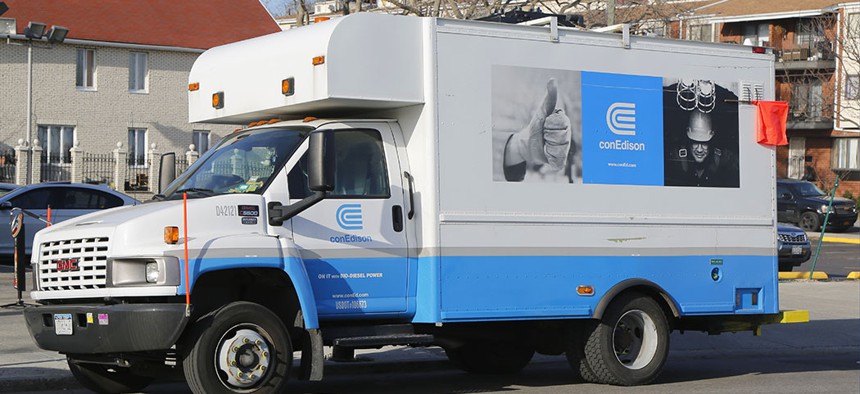New York City
Why did Con Edison cut power in Brooklyn?
On Sunday evening, Con Edison took the somewhat extraordinary step of pre-emptively cutting power to 33,000 customers in Southeast Brooklyn. Here’s why the unusual decision was made, whether it might happen again, who is at risk in the future and if the utility will face any repercussions.

A Con Edison repair truck. Leonard Zhukovsky/Shutterstock
On Sunday evening, Con Edison took the somewhat extraordinary step of pre-emptively cutting power to 33,000 customers in certain Southeast Brooklyn neighborhoods, including Canarsie, Flatlands, Mill Basin and Bergen Beach, in response to the weekend’s intense heat. (A total of 52,000 customers lost power throughout the Con Ed service area.)
As of Monday afternoon, 14,000 were still without power in Brooklyn. It planned to bring power back to the remainder in the afternoon. Here’s what you need to know about the unusual decision to cut power – why it happened, whether it might happen again, who is at risk in the future and if the utility will face any repercussions.
Why did Con Edison do it?
According to a statement from the utility on Monday, its actions were “necessary to prevent longer outages to the impacted customers” that could have resulted from damaged equipment. Earlier on Sunday, Con Edison had sent out an advisory asking that customers in Southeast Brooklyn reduce their energy usage. They sent similar advisories about certain neighborhoods in Queens and the Bronx as well, although those neighborhoods did not have their power cut.
Allan Drury, a spokesman for Con Edison told City & State that before it turned off power to customers in Southeast Brooklyn, about 3,000 customers were already experiencing blackouts in the area. Drury said the utility expected more outages as equipment, including overhead lines and transformers, got hotter, so taking the pre-emptive step was meant to limit the duration of existing and expected outages. He added that cutting the electricity was also meant to prevent blackouts from cascading to other customers where equipment was beginning to overheat.
Richard Berkley, executive director of the consumer advocacy group Public Utility Law Project, said that Con Edison’s explanation is certainly plausible. While he acknowledged that it isn’t easy being a utility in New York, he added that heat waves are not unexpected and it should be able to handle them.
Is this common?
Drury said the actions taken by Con Edison on Sunday do not happen very often and said that “anything of this scale” as the result of excessive heat has not happened in recent history. He said that it’s far more common to reduce voltage to areas utilizing a high amount of energy, which Con Edison did in areas of the Bronx and Queens. Berkley said the practice of cutting power is more common in California – a utility in state took that step in June in order to reduce the risk of wildfires. However, Drury said that Con Edison did turn off power to the southern tip of Manhattan ahead of Superstorm Sandy in 2012 in order to prevent damage that could have lead to widespread blackouts. Drury said that Con Edison has one of the most reliable grids in the country, but said that the heatwave resulted in record-setting electricity demand. At 6 pm Sunday, he said that the electrical load, the amount of power it sent out, reached 12,063 megawatts, breaking the previous record of 11,855 megawatts set during a 2016 heatwave. Drury said the load, combined with three days of extreme sustained heat and humidity, put enormous stress on the system.
Is this likely to happen again?
Drury wouldn’t comment on the likelihood of Con Edison cutting power to customers in the future. He said that when the summer ends, the utility will begin analyzing its system to determine where it should make investments. Drury said Con Edison invested about $1.5 billion into its system in preparation for the summer of 2019, which is a fairly standard amount. However, as extreme heat and become more commonplace because of climate change, the strain that resulted in the power cut may become more common as well. In the case that Con Edison does cut power in the future, Southeast Brooklyn is not any more likely to be the victim of the outage. The decision on Sunday was made based on specific conditions at the time, not any inherent weaknesses or vulnerabilities in the Brooklyn neighorboods, according to Drury.
Can Con Edison get punished for cutting power without warning?
Con Edison operates under a contract with New York state and is thus subject to state regulation. The Public Service Commission oversees Con Edison and other utilities and has the power to investigate and order sanctions against those that breach the contract or engage in other forms of misconduct, up to and including revoking the utility’s contract. Gov. Andrew Cuomo had already ripped into Con Edison and directed the Department of Public Service, the staff arm of the commission, to investigate Con Ed following Manhattan’s blackout last weekend that resulted from and threatened to kick the utility out of the state. The governor echoed those remarks Sunday evening, and New York City Mayor Bill de Blasio offered similar sentiments on Monday. Berkeley expects to see something from the department within the coming days. He said the independent investigation will reveal information, such as how Con Edison has been investing its money, whether it has been making those investments wisely and why the utility wasn’t adequately prepared for the heat wave. The commission will decide what, if any, punishment to impose at the investigation’s conclusion.
NEXT STORY: A new way for ride-hail drivers to fight back?

